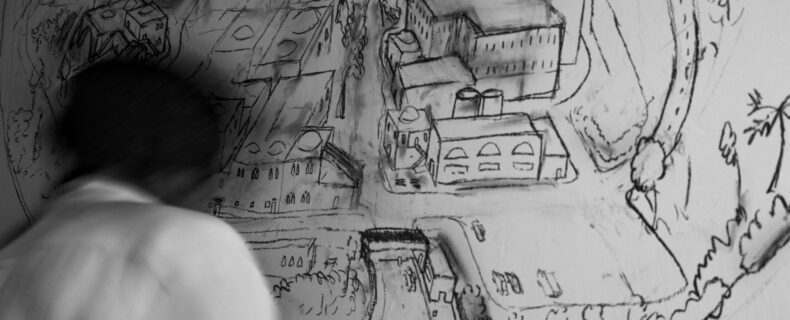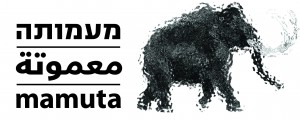The OWL LAB

The OWL LAB
Ronen Eidelman, Eyal Bitton and Amir Meir, Hadassa Goldvicht, Guy Dolev, Ruth Danon, Sharon Tal, Davíd Lockard, Lonnie Monka, Mica Kupfer
Curators: Sala-Manca
7/1/23-24/3/23
The OWL Lab — a laboratory for Objects, Words, and Labyrinths — began activities in February 2022. The performance lab was founded within the Theater Department at Hebrew University in Jerusalem in collaboration with Mamuta Art & Research Center, which is operated by the Sala-Manca group (Dr. Diego Rotman, head of the Department of Theater History at the University, and Lea Mauas, the Artistic Director of Mamuta). The laboratory was born out of a desire to research and create through: reenactments, hacking, and reusing outdated technological equipment (slide projectors, book conveyors, an analog Moog, and more); signs and operating instructions from other laboratories in the university; as well as new uses of archival material whose time has passed, teaching materials, and pedagogical practices from the past.
Within the performance lab, nine artist and graduate students engaged in various practices for the transmitting and (de)archivization of knowledge. While working with the “useless” and with that which has fallen out of use (the obsolete), the underlying approach of the lab’s activity was creation-research, which aimed at a critical reconstruction of pedagogical events as well as outdated research methods, some of which have been relegated to the margins of academic practice. This approach aspired to create experimental recycling-based practice aimed at producing old-new knowledge. The lab also engaged with the question of how technological innovations influence the design of artistic, performative, and pedagogical experience.
This exhibition turns the rooms of Mamuta into both exhibition spaces as well as a place for members of the lab to continue performing research while enabling these practices to meet a public audience. The duration of the exhibition will also be a time for the leaders of the lab to write and reflect on its first cycle.
About the Works & Projects
At the heart of Eyal Bitton and Amir Meir’s project stands a restored analog Moog synthesizer that was used by the researcher and composer Yosef Tal. Beside the instrument, a documentary-fiction film will be shown. This film deals with the archeology of the medium, the poetics of the device, and stories of its pioneers. Lonnie Monka, following the poet David Antin, will use interactive transcription stations that he created in collaboration with Eran Hadas. His work researches the meeting of speech, text, and the historical avant-garde. The choreographer Mica Kupfer focuses on the traces of movement that the processual history of choreographic work is not able to preserve. In an attempt to maintain a memory of the lost “raw material,” she produces footprints and sound in a space where the body no longer remains. The musician Ruth Danon researches alternative ways of producing music, through an investigation of tremor – an involuntary rhythmic movement that involves body parts vibrating. This investigation will check which sounds the body creates when it tremors and what this free shaking reveals. At the center of Guy Dolev’s work, there are “blind” images of watching without sight or consciousness. With the help of a slide projector, which was used by the Department of Art History at the Hebrew University, Dolev documents an eye operation that is projected on a huge monitor at the Hadassah Ein Kerem Hospital. For both the hospital and the university, projection is used for initiation into a discipline and discourse of the gaze. Drawing from memory throughout the exhibition, Davíd Lockard will create maps of Kfar Shaul. This work is an attempt to express an ongoing personal interest in issues related to forgetting and the connection between the representation of a space and the attempt to recall what happened there. The actress and performance artist Sharon Tal researches the past as an experiential means that produces alternative narratives. Her work is based on her relationship with her father as together they perform a dialogue written in collaboration with the writer Mai Resh. Ronen Eidelman established the Institute for Positive Technology, an activist research institute that examines the role and uses of surveillance technology in contemporary society. The basic assumptions of the institute are that we have the ability to amplify the benefits of surveillance technologies and to better cope with their inherent dangers – turning the worrisome into the familiar, the complex into the understood, and the negative into the positive. Hadassa Goldvicht will present a fragment from a long-term documentation project. The fragment focuses on signs of life that were recorded in the warehouse of the National Library, in Givat Ram, which are being emptied in preparation for the library’s move to a new location.
Mamuta Art and Research Center
Artistic and general direction: Sala-Manca (Dr. Diego Rotman and Lea Mauas) | Assistant curator and projects manager: Naama Mokady | Technical and exhibitions set up: Eytan Habib |Graphic design: Maya Shleifer | Sound consultation: Amir Bolzman | Text editing: Inbal Keidar | Arabic translation: Nagham Abuleil | English translation: Lonnie Monka | | Image: David Lockard, Photo by Bar Russo
Opening hours: Tue – Thurs 13:00 – 18:00, Fri 10:00 – 14:00
===
Additional events at the exhibition:
The first Hebrew Synth seminar | 24.1, 20:00, Hansen House’s attic
Among the participants are Tomer Damsky, Eran sachs, Eyal Bitton, Amir Meir.
A small group of artists and researchers, is engaged in the restoration of a studio founded by composer and electronic music pioneer Yosef Tal in the early 1960s. The group also shows a documentary but abstract film about the process.
===
Open gathering with the Moog – Amir Meir and Eyal Bitton
Lisbon Cinema at Mamuta Art and Research Center, Free entrance | 21.2, 13:00 | 28.2, 19:30
At the meetings, we will watch a demonstration by Amir Meir on the Moog, learn more about it and watch the movie.
===
Hyperphrasis: an evening of writing, talking, technology & performance
Mamuta Center, 22.2, 7 pm. Guidance by Lonnie Monka and Eran Hadass
What is hyperphrasis? In part, this term extends the poetic genre of ekphrasis, which usually consists of poems that relate directly to plastic artworks. Hyperphrasis utilizes the potential of projecting live transcriptions to explore how speech itself can become art. With that question in mind, this event will consist of two segments. First, there will be an ekphrastic writing workshop led by Lonnie Monka. Visitors are welcome to discuss and then write about the works exhibited at Mamuta. Then they will be invitied to read or perform their poems beside the interactive transcription station that was set up by Lonnie and Eran Hadas. Second, Lonnie and Eran will perform their own poetry, exhibiting their ongoing interest in exploring the new creative possibilities that emerge when interfacing with transcription software.
The event will take place in both English and Hebrew, but participants are welcome to write and read in whatever language they prefer | Free entrance
===
Songs of the Owl | facebook event
10.3, 11:45, Mamuta Art and Research Center| Free entrance
Mamuta Center is pleased to invite you to two short live performances developed in the frame of the OWL LAb and exhibition
Guided Tour | Davíd Lockard in collaboration with Michal Goldstein
A short show about memory and oblivion as part of the work at the exhibition ‘Tour’. Michal Goldstein will sing and play, David Lockard will narrate.
===
Etude for a white stage at the exhibition. 2×2 | Mica Kupfer in collaboration with Erez Meyuhass
18.3, 19:00, Free entrance
A man and a woman and their instruments: the body and the double bass.
Choreography: Mica Kupfer
===
“Digital surveillance during a protest” workshop with Ronen Eidelman, March 20th, 8:00 p.m.
Whether you participate in demonstrations and protest activities or whether you follow and encourage – whether for or against – you are being watched. We are all being watched.
In the digital surveillance workshop, we will discuss the forms of surveillance and information collection used by the police and various government agencies, and we will learn about different types of surveillance. We’ll think about what to worry about, provide practical strategies for responding to surveillance, and ways to protect our privacy and that of our friends.
The purpose of the meeting is to formulate ideas for a safer activity, and to develop a toolbox for protest with technological awareness.
Among the topics in the workshop:
* What is tracking? Where does it take place and what does it serve?
* The good and the bad about tracking
* How is data collected – and for what?
* How to reduce the damage of surveillance
* Surveillance in art – examples and discussion of the ethical considerations and consequences of surveillance in arts
We will provide practical strategies for responding to surveillance in their lives and work, including ways to protect your privacy and that of your communities, and how to challenge the use of surveillance in private and public spaces.
Duration of the workshop: hour and a half || Please bring a laptop/smartphone || Free entrance
===
A body within a body within a body
You are invited to an artists talk, a screening and a work with audience participation as part of the exhibition “The OWL LAB”
March 23th, 19:15, Mamuta Center
4-8Hz: questions about tremor || Ruth Danon: Headphone work with audience participation
Text and audio work for joint listening in headphones. The work includes a variety of vibration sounds produced during the months of the research, alongside texts in Hebrew and English that try to get to the bottom of the experience of physical tremors, listen to it, describe it and ask questions about it: What does tremor reveal and what does it enable? What is between internal tremor and external tremor? And what about control, fear or shame?
Biblioscopia: On the relationship between library, recovery and body || Hadassa Goldvicht conversation with Moshe Kanner
In her work “Biblioscopia” Hadassa Goldvicht documented the basements of the National Library in preparation for the library’s move from the historic building in Givat Ram to its new location. In this special evening, Goldvicht will talk with Moshe Kanner, a librarian at the National Library’s warehouses for thirty years, about books, letters, body and memory and the evolution of the relationship between librarians and readers.
The conversation will be in Hebrew.
Funeral for my living father || Sharon Tal: Screening of a short film and a conversation with the artist
In this scene the father in the role of the father and the daughter in the role of the daughter embody their dual roles with the theatrical legality of a lie for the sake of truth, in a conversation that could only have taken place on stage.
For registration without payment >>


